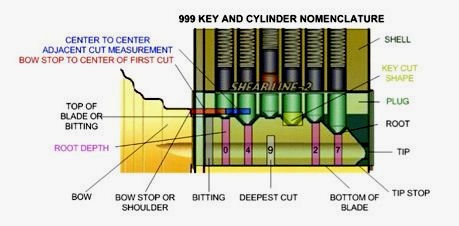by Nick Gromicko, CMI® and Kenton Shepard
What Is a Bump Key?
Most people think a locked door affords them security, but to anyone who knows how to use a bump key, a door lock is just a minor inconvenience.
Bump keys are keys cut to a special design that will allow them to be used for picking pin-tumbler locks. Pin-tumbler locks are the world’s most popular lock, and these include exterior door entry locks for homes. The process of gaining entry using a bump key is called “bumping,” and it can be very effective.

Above: a pin-tumbler lock
All the cuts on a bump key are made to the maximum depth, so any key blank can be made into a bump key. Bump keys are manufacturer-specific. A Kwikset lock requires a bump key made from a Kwikset key. The same is true for other lock brands. So, a full set of bump keys would include one for each of the major lockset manufacturers.
How Does It Work?
Keys operate by aligning tiny spring-loaded pins inside the lock. Once the pins are correctly aligned, the cylinder will turn and the lock can be operated.
To use a bump key, the “pull-back” method is common. With this method, the key is inserted all the way in, and then pulled back out one notch. While keeping rotational pressure on the key, it is then bumped into the keyway with the heel of the hand or with a device of some sort.
The “bumper” needs to bump the key hard enough to jar the pins, but not so much that the lock or key is damaged. Bumping the key causes the pins to jump slightly. Even this slight amount of motion is enough to allow the bump key to turn the cylinder, unlocking the lock.

The image above-left shows the condition just before the key is bumped. The image above-right is just after the key has been bumped. The driver pins (in blue) have bounced above the shear line, while the key pins (in red) are still below the shear line. As long as the shear line is unblocked, the cylinder can turn and the lock will open.
Another method for using a bump key, called “minimal movement,” is slightly more sophisticated than the pull-back method. Bump-key performance can be improved by filing away an additional 0.25 to 0.5 mm from the key tip and shoulder, allowing the key to be inserted slightly farther into the lock.
How Effective Are Bump Keys?
The success of the bumper depends on practice. Very little skill is required, and the learning curve is short. Success will also vary with the type of lock and quality of the key. Keys made from soft metal won’t last long. Bumping tends to work better on more expensive locks, since the hard, high-quality parts work more smoothly.
Bump keys sometimes deform when they’re hit, causing them to jam in the keyway. They can be difficult to remove.
How Can I Tell If a Lock Has Been Bumped?
You can sometimes spot a lock that has been opened with a bump key if you see a small indentation just above the keyway. Some older, softer locks will have dents even though they have not been bumped.
It’s also possible to make bump keys that are protected from leaving indentations. You may be able to tell that a lock has been bumped, but don’t count on it.

Above: a typical bump key
Can I Buy a Bump Key?
Owning or possessing a bump key is not currently illegal, and bump key sets, and videos on how to use them, are available online. To acquire a bump key, all that’s needed is the identification of the manufacturer of the lock.
How Can I Improve My Home’s Security?
At least two companies, Schlage and Baldwin, make locksets designed to defeat bump keys. But many locks that use a key and the pin-tumbler system are vulnerable to bumping. No standards exist which demonstrate resistance to bumping. The resistance to bumping a deadbolt lockset varies with the manufacturer. Electronic locks that have a key override are also vulnerable.
Bump-proof locks are rare and expensive. Bump-resistant locks are much more common. Some (but not all) lockset manufacturers include bump-resistant features in their newer locks.
Without buying a new, bump-resistant lock, consumers have two options. Usually, for less than $20, a locksmith can replace the original lock pins with “mushroom” pins, sometimes called spool pins, depending on the manufacturer. While these pins will improve the resistance of the lock, they will not make it bump-proof.
Medeco is a company that makes high-end locks. They can provide bump-proof lock cylinders for which a duplicate key is available only through Medeco-authorized dealers. Their cylinders start at around $100, although their less-expensive cylinders may not be bump-proof.
Will Insurance Cover Theft?
If a home is burglarized using a bump key, the theft may or may not be covered by insurance, depending on how the policy is written. If proof of forced entry is required, the theft may not be covered. Be sure to consult your insurance agent with questions about this.
Although bump keys have been around for more than 50 years, their existence has become more widely-known with the advent of the Internet. Consumers should be aware of this potential danger to their home’s security.
In summary, home inspectors should warn their clients about making sure their door locks are sufficiently secure to prevent unauthorized entry by someone using a bump key. Taking extra safety precautions, such as installing an alarm system, can provide homeowners with enhanced protection of their property.




